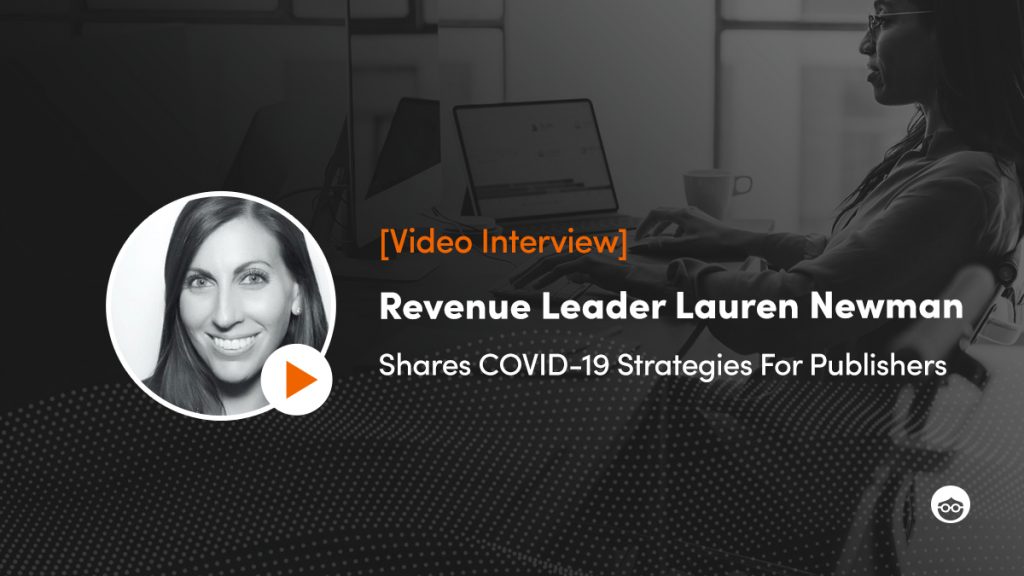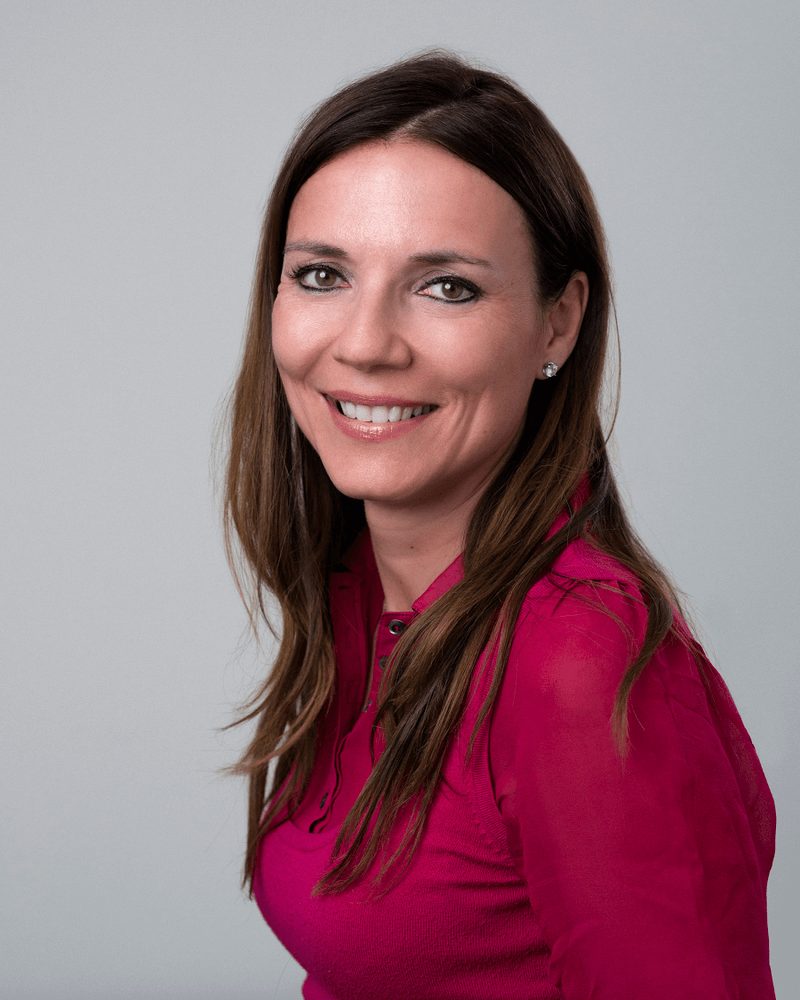[Video] Exclusive Interview With Lauren Newman: Supporting Publishers Through COVID-19

COVID-19 — the acronym that’s pained our world for months.
And, in our industry, hit the pockets of publishers — as we’re seeing continued layoffs, furloughs, and bankruptcies given the loss of advertising dollars amid the crisis.
No publisher should have to choose between paying its staff or bringing important information to their community, so we began a five-part series of Revenue Optimization articles, as well as expert interviews with industry leaders, to help support actionable strategies to consider during these trying times.
So, I was given the lucky opportunity to sit down — virtually, of course — with Lauren Newman, the fantastic SVP of U.S. Revenue at Skimlinks (recently acquired by Connexity!), which focuses on commerce-driven content creation for publishers.
What was originally planned to be a casual talk turned into a tutorial for Sales Teams on how to manage uncertainties, as we’re experiencing with the coronavirus.
For background, Lauren Newman is a rockstar Sales Executive and veteran of the publisher space. She’s led 9-digit-revenue business units at household publishers like Meredith, Time Inc., and Conde Nast, driving advertising revenue across CPG clients.
She has the people skills to sell lipstick to Mitch McConnell and the brainy chops to leverage data to drive multifaceted marketing programs. So, you better listen up.
Q&A
1. How are publishers filling in the revenue gaps with short-term strategies such as Affiliate or Display? And do you think these short-term plays will turn to long-term plans beyond the effects of COVID?
TL;DR
Tough times have called for greater risk-taking at the sake of monetization — though will lead to better reader loyalty over time.
TS;WM
“I think they were seen as two very different revenue streams, right? There was like the Display revenue stream and there was the Affiliate revenue stream — and sometimes, those pages didn’t connect. Most publishers have a separate Commerce strategy where they produce content with Affiliate in mind, but they’re not thinking about Display on those pages, for instance. And then, they have their Editorial strategy, where they are thinking about Display units.
I think those two worlds can live a lot better together. We can have a lot more contextually-relevant ads on content that also has serviceable links for that Advertiser.
So, I think it was a strategy that people enacted now, short-term, to at least monetize high-traffic pages that were getting zero ad revenue. But, building that base of consumer behavior will only pay off for them in the end because once consumers are trained to shop from you and see you as a serviceable destination, they will come back and they will continue to transact with you forevermore. So, I do think it becomes a much longer-term strategy.”
2. How do Direct Sales teams fit into these publisher equations, especially when it comes to an Affiliate strategy?
TL;DR
Everything comes down to collaboration.
TS;WM
“It’s a collaboration. So, I don’t think Direct Sales teams should be turned into Affiliate Sellers — but, I think they should work with their Commerce teams to understand top-performing Merchants, right? Typically, top-performing Advertisers and top-performing Merchants are a very different mix of retailers. And so I think it’s also great prospecting tool for Direct Sales teams to really understand the types of Merchants that are converting on their sites, and then go to some of those Merchants to say, “Hey, you’ve never advertised with us, but we drive a million dollars in order value for you a month, so obviously, our consumers are interested in your product — how do we form a larger partnership here?” And how do we bake that into Media, into Branded Content, into Affiliate, into Events — whatever that’s going to look like — to build a much more comprehensive strategy for that Marketer?
A lot of the Affiliates, you know, or a lot of the direct-to-consumer brands — the DTC brands — that haven’t traditionally advertised on large publishers. But why aren’t they if large publishers are the ones who are driving the most amount of conversion for them? I think it’s a great prospecting tool for Direct Sales, and for them to actually work with their Affiliate teams to understand how their consumers are interacting with their content — and is there a bigger opportunity to partner with some of those brands?”
3. After the COVID dust has settled, do you think more Publishers will focus on lower-funnel, conversion-driven strategies?
TL;DR
The emerging Performance Editorial category will take reign as the lines continue to blur across publisher teams.
TS;WM
“Well, I think one of the best ways — one of the best reasons — to bundle Display and Affiliate is because this at least you get a lot better performance metrics in the Affiliate channel. I think it’s still going to be very hard to have really positive actions and ROI against ad units, right? But, if you can actually bundle the two together to say, “Hey, we served you X amount of impressions through both Display and through Content, and here was the ROI against the combined entity,” it becomes a much more attractive proposition.
The space that I do think will blend together, and has already been blending together, is Branded Content and Sponsored Content through the Affiliate channel. That’s something we’ve seen a huge surge in on our side in the last, really, I mean, not just year — really, in the last six months — that Marketers and Brands now are looking to have guaranteed Commerce Editorial for much lower investments than, you know, Custom Content that publishers are producing in-studio or on-location. And so, I think those two things are going to be very hard to remain separate for a long time — and they will blend, and it’ll basically be a new type of content of Performance Editorial.
And it’s sponsored and plugged the same way, you know, that Brand Content is, but it has guaranteed metrics against it. Whereas Publishers, when they are selling Sponsored Content, typically, you know, the KPIs against that are impressions, shares, likes, and comments — you know, very, very fluffy metrics — as opposed to sales, order value, and conversion rate.
So, I do think those two worlds will merge, and I think publishers will be better for it because I think it’ll give Marketers a lot more comfort that their products are actually being purchased through that content, not just, you know, being introduced to an audience.”
4. This type of Performance Editorial would ultimately bring the Editorial or Commerce and Product teams together. Is that collaboration time-consuming or challenging for publishers?
TL;DR
Emotionally, yes. Structurally, no.
TS;WM
“I think it’s more of an emotional question on, you know, church and state — and what the publisher’s comfort level is merging those two worlds. We’ve certainly seen publishers be very comfortable, you know, in the Brand Content space, in the Native space, where they really do blur the lines between Editorial and Advertising, and some who are not there at all.
So, I don’t think it’s a hard shift from a product standpoint — I think it’s a hard shift from a strategy standpoint, depending on how strongly they feel about converging the two worlds.”
5. When it comes to monetizable pages in the midst of a crisis, are there any tactics Direct Sales teams oversee to keep Marketers spending?
TL;DR
Philanthropic messaging works twofold: for client promotions and publisher promotions.
TS;WM
“I think that’s why the philanthropic angle works really well. If you have a Paid campaign from an Advertiser, and you can, you know, give them X amount of bonus impressions, and the bonus impressions can run on those high-traffic pages around sensitive topics, but with a philanthropic message, that’s a great way to at least lock in dollars on other pages, but still, you know, fulfill the ad slots on high-performing pages.
So, I think that’s been a good strategy that publishers are looking at it like, “Well, hey, use it as an opportunity to tell this audience, who obviously cares about this topic, what you’re doing to lean into it.” Because that could also help your brand awareness and favorability in a time like this and then we’ll use, you know, pages that you’re more comfortable being on for your actual Paid dollars.”
6. So, in a time like this, is the best tactic to upsell your existing Advertisers, or to discover new Advertisers?
TL;DR
Use your existing Advertisers to determine your new Advertisers.
TS;WM
“That’s one. And I’d say the second is to find new Advertisers, who have really popped up because of the causes, right? So like, you know, with the pandemic, we’re seeing, obviously, facemasks as a top-performing category in Commerce. And there’s a ton of brand-new Merchants that you’ve never heard about before, that consumers never experienced or looked for, who are providing a great, you know, consumer service right now by offering things that you actually need to survive this time.
Go prospect against those people, right? Those people certainly have dollars now — they’re seeing tons of orders come in, they certainly have money to start promoting. So, I think it’s a good time to look at a new Advertiser base.
You know, with all of the racial injustice issues, we’ve been recommending to publishers to look at black-owned businesses — there are plenty of black-owned businesses that get zero share of voice across these publisher pages — both Editorially and through Display. Go prospect and partner with them. And talk about how you want to give a larger share of voice to black-owned businesses, not only editorially, but to your consumer base by having Display run across your site.
So, I definitely think it’s an opportunity to find new Advertisers that have traditionally not partnered with you and have not frankly been a big consumer-focus for your readers, but now, are critical merchants for your audiences to be introduced to.”
7. What about Direct-to-Consumer Advertisers? How feasible is it to get those DTC dollars into a direct buy with a publisher?
TL;DR
If and only if there’s an Affiliate play baked in.
TS;WM
“I think it’s feasible with an Affiliate play. I think it would be very hard to get the ad dollars standalone — I think you have to have a performance metric baked in there. So, if you’re comfortable enough to guarantee X amount of sales and conversions off of Display, maybe you’ll get it. But, I think if you combine it with an Affiliate strategy on performance through Commerce and Editorial, and then put the Media on top of that, I think it’s very likely.
And I think we’re already starting to see that with some DTC brands. Like Everlane, who has traditionally grown up just in the Affiliate channel — a little bit of social, but really just for Affiliate — is now doing Branded Content with some of our publishers because they want that guaranteed exposure. Now, they’re big enough that they can support that and have the dollars to support it.”
8. During COVID, we’ve seen Video dollars take a huge hit. How do you think Video will rebound as we surface from the crisis?
TL;DR
Less self-promotional — more consumer-servicable video.
TS;WM
“Well, I think Video is challenging because I think mostly the Video that everyone is watching is news-driven right now, and very sensitive types of videos that most Marketers don’t want to be bookending with frivolous messaging.
But I think the opportunity for publishers to, like, provide serviceable video, you know. Like everyone is online streaming workouts and meditation classes, and you know, other things that people need to now do virtually. And publishers haven’t really produced a lot of that content on their own. They’re promoting apps and services that do that, but they haven’t actually had, like you know, a Health Editor lead a yoga class online, and I think if they started doing things like that, they could bookend that content no problem because it’s very intrinsic to the brand, it’s a customer service, it’s something that people would tune into. And there’s a ton of like health-minded Marketers, who probably want to sponsor content like that — that feels relevant and on-trend, but also covers a sensitive topic in a productive way.”
9. Do you think there’s an opportunity for publishers to tap into the use of Influencers for content creation? Or, do they really prefer to create their own content?
TL;DR
Partnerships tend to erode margins, so publishers should consider more grassroots, UGC-based content.
TS;WM
“I think there are definitely opportunities to partner. I think just given how depressed the space is already, obviously, any partnerships just further erode your margins, so they might not have enough economics right now to be able to support that. But, I think publishers have gotten past that “we have to do everything ourselves” and are okay leaning across the aisle to partner with people to do things that think already have a built-in following, have done it really well, something that they don’t have to spend tons of money in Paid Media to promote because you know, having a built-in audience is a huge win.
But I haven’t seen a lot of them do it yet, so I’m not sure why. I don’t know if it’s just because, like I said, the economics aren’t working right now. But I think, you know, unlike how publishers have been handling Video — which is very expensive, in-studio, on-site, custom photo shoots — doing an at-home workout with one of your Editors could cost you virtually nothing. There’s a very different catalog of content right now that they could be producing that would have almost zero overhead that I think would also be really well-received, and you know provide a service to their audience.”
10. What’s stopping publishers from working with Influencers? Are they seemingly stuck in their ways?
TL;DR
Quite the missed opportunity for publishers.
TS;WM
“I don’t know — maybe it’s like a lack of wanting to send people like equipment with like lighting — you know, I don’t know. But I haven’t seen anybody do it, and I think it’s such an easy, natural thing. I mean, you know, all the Beauty Editors started to do beauty videos from the train or from their bathrooms. And during this time, I think they can be doing so much more — at-home haircuts, you know, at-home relaxation tips, how to get rid of acne from a face mask. I mean, there’s tons of content they could be doing that I’ve seen Marketers do — you know, Brands are doing it — but I haven’t seen a lot of publishers do it, and I think they should.”
11. How do you think WFH is affecting Direct Sales teams on the publisher side?
TL;DR
Significantly hurting Acquisition tactics.
TS;WM
“Yeah, I mean, obviously I’m not running a Direct Sales team today, so hard for me to totally know — but my guess would be that relationships with the existing customer base are fine, you know. They’re having check-ins, they have access to them, they can get on calls with them, they can get on a video with them. But I would imagine Acquisition has taken a huge hit because I think it’s probably very hard to reach out to people blindly and try to get a video call with them in their homes, which feels a lot more personal than taking a phone call. So, I would imagine Acquisition has dried up significantly. And that it’s more about them trying to maximize their existing base because they already have good relationships built-in.”
12. At Skimlinks, how have you taken on Acquisition in the midst of today’s crises?
TL;DR
Providing an alternative revenue stream for publishers.
TS;WM
“Yeah, I mean, we’ve been doing tons of email outreach. I mean, for us, just talking about how our space has obviously exploded during this time, and really, you know, coming from it at an angle of like, “We can actually help you right now.” Because a lot of publishers are trying to figure out alternative revenue streams outside of Display and Video. So, you know, just kind of underscoring the fact that you have an alternate revenue stream sitting right here in front of you that we can help you monetize, and build, and stand up very quickly.
Some publishers we hear back from right away, like, “Yes, we need this, and thanks for reaching out.” Others are like, “We know we need it — we just don’t have a dedicated person to have you even talk to right now.”
You know, everyone’s so stretched so thin and so, you know, scrambling to save the core business that we actually can’t even think ahead on how to build something for the future. And I think that’s a problem because, I mean, if you’re not able to think ahead and not be forward-thinking, you’re only going to be caught mitigating decline.”
13. Many publishers are adding more revenue partners or ad units as a means of making up revenue loss. Isn’t this detrimental to the user experience, and ultimately, business in the long run?
TL;DR
Better to do it right, at the cost of a bigger loss, than do it haphazardly and hurt more down the line.
TS;WM
“You’re just trying to save what you’ve already been doing. But it takes the bravest people to say, “Okay, well, we’re already going to experience a 40% decline right now organically. You know what? Let’s take a hit at 60% and change everything that we’ve been doing.” It’s a very brave thing to do, but I think it’s the right thing to do because no matter what you do that 40% decline will be mitigated, what 5% or 10% max? But if you can take a slightly bigger hit and completely change a strategy and hopefully build back not only that 40%, but then build another 40% on top of it in six to twelve months, well, you’ll be a lot better for it.”
14. How have you been helping publishers through such crises over at Skimlinks?
TL;DR
Daily newsletters, merchant spotlights, philanthropic highlights — you name it, we’re testing it.
TS;WM
“Yeah, I mean, we’ve been sending out daily newsletters to show them, you know, top-performing Merchants — so people that maybe they hadn’t considered in the past that they should consider now based on who’s performing, based on obviously environmental issues.
New Merchants who have come onto the scene — a lot of Merchants, despite what’s happening, are still joining the Affiliate channel because it is pay-for-performance so they know at least if they are going to invest the money that they get it back in the end. So, we actually have like 30 to 40 new Merchants joining the network a week, so we’ve been introducing them to those Merchants, so that they can, you know, test and try with new people.
We’ve been giving them content suggestions so, “Hey, here’s all of the things that are performing against not only your competitors, but the space in general. Here are some ideas that maybe you should think about covering editorially and see how it works for you.
It’s something we’ve done for a long time — really, obviously amped it up during this time. And, you know, the first probably six to eight weeks, people were like “Yeah, yeah — we’re good with what we’ve been doing.” I’d say in the last two months, we’ve really seen a major shift with people are taking our suggestions exactly as we recommend, and they see them pay off, because it’s built-in performance metrics, right? It’s data-driven — it’s not emotionally-driven, or driven by gut or instinct. We’ve seen some really good success there.
And we’ve been highlighting Merchants that are giving back. So, really trying to highlight those who are leaning into the time, leaning into philanthropy, giving back to the causes that we’re all dealing with right now. So, that there’s also a feel-good moment for the people that they’re partnering with because I think publishers feel a huge responsibility right now also answer to their readers on how they’re responding to these things. So, I think that if we can give them an angle to say, “Hey, you should cover some of these people, and then you can tell your readers how you’re going to be promoting, you know, these Merchants, these retailers, these businesses — it looks good for you, it feels good for your revenue, and it feels good for the consumer.”
15. With existing publishers, is your goal to get them associated with the content that they are creating? And with new publishers, has the responses been more frequent?
TL;DR
50-50 split.
TS;WM
“Mhm. And particularly for them to diversify away from Amazon, which is always the number one goal.
Yeah, I’d say it’s 50-50. I’d say some who are on the fence about it have either said, “100% — this is the time, let’s talk.” Or, some are like, “We know we need to do it, we just can’t focus on it right now.” A lot obviously have had layoffs and furloughs — the Editorial team’s usually first, and they’re the ones creating the content with Commerce in mind. So, I think depending what the situation is at each publisher, we’re either finding that they are expediting this or they are backburner-ing it.”
Skimmable Insights
Wow — amazing insights, Lauren!
Here’s a quick summary for all of my skim-readers out there.
- Publishers would greatly benefit from combined strategies between Editorial, Affiliate, and Display teams — the less separation, the better.
- Performance Editorial is the hot, new trend — blending data and content.
- Philanthropy-related campaigns are high-performers, both to establish better relationships with brands, and even better relationships with readers.
- Sales should focus heavily on retaining existing clients, then find opportunities with the high-performers — for example, with certain verticals that are booming like Health & Fitness or Beauty.
- Serviceable Video — grassroots, inexpensive, engaging — try it!
Interested in discovering the power of Native Advertising yourself?
From total revenue growth to lasting audience engagement, it’s a no-brainer for publishers and media outlets — especially during these times where every dollar counts, without harming user experience or brand affinity.













